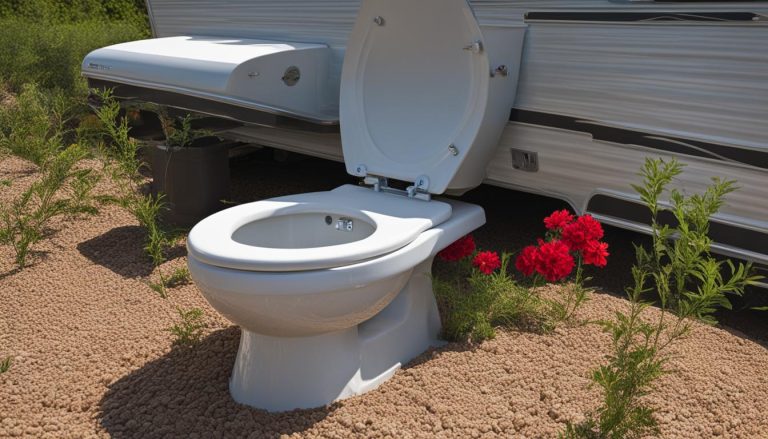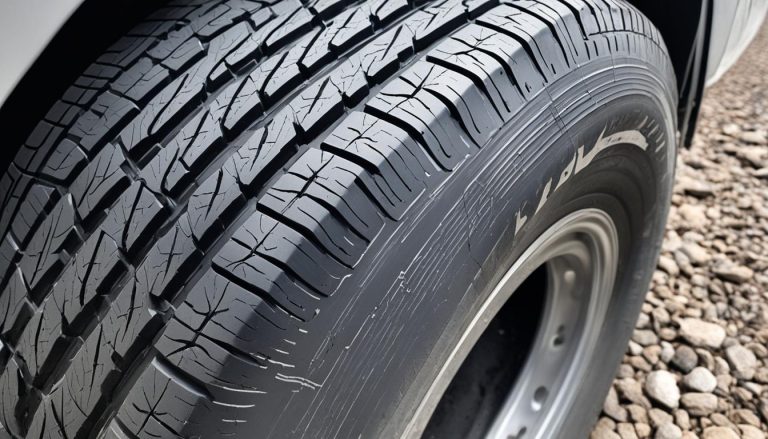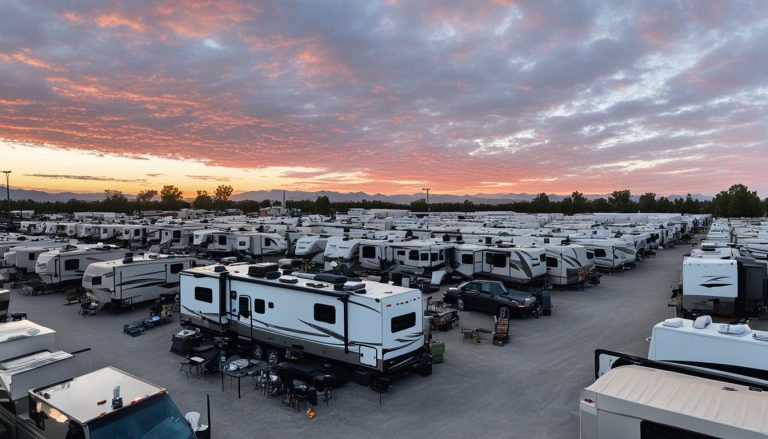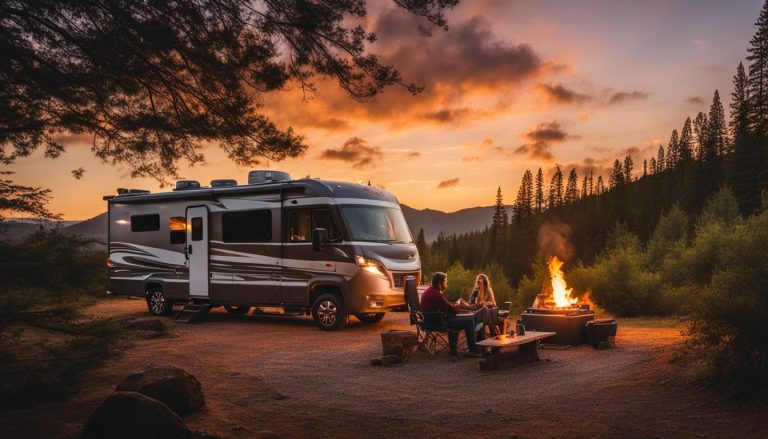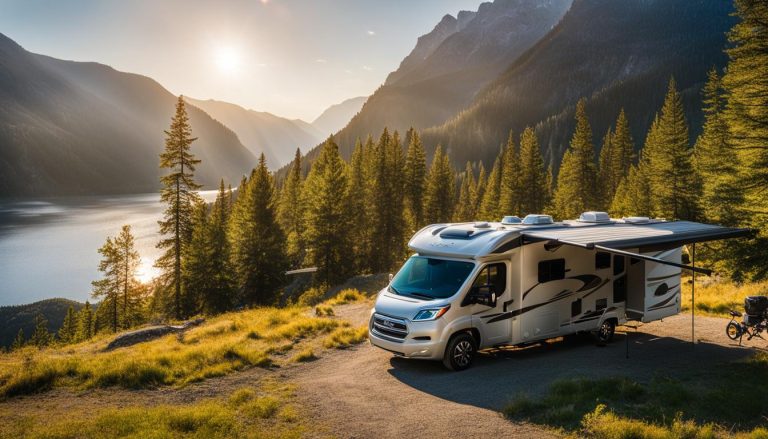Sanitize RV Water: A Step-by-Step Guide
gorvlifestyle.com and its partners may earn a commission if you purchase a product through one of our links
To ensure safe and clean water in your RV, it is important to regularly sanitize your RV’s fresh water tank. Sanitizing the water tank helps remove any bacteria, mold, or other contaminants that may be present. This guide provides step-by-step instructions on how to properly sanitize your RV’s water tank.
Whether you’re an experienced RVer or new to RVing, learning how to sanitize your RV’s water tank is an essential skill. By following these simple steps, you can ensure that the water you use for drinking, cooking, and showering is clean and safe for you and your family.
Key Takeaways:
- Regularly sanitizing your RV’s fresh water tank is crucial for clean and safe water.
- Sanitizing removes bacteria, mold, and other contaminants that may be present.
- Follow a step-by-step process to properly sanitize your RV’s water tank.
- Consider using specialized products for RV water sanitization.
- Maintain a clean RV water system to prevent contamination and ensure longevity.
How Often Should You Sanitize Your RV Fresh Water Tank?
When it comes to ensuring clean and safe water in your RV, regular sanitization of your fresh water tank is crucial. By following a recommended schedule for RV water tank sanitization, you can maintain the quality of the water you use for drinking, showering, and washing dishes. So, how often should you sanitize your RV fresh water tank?
It is generally recommended to sanitize your RV’s fresh water tank at least once a year. This yearly sanitization helps remove any bacteria, mold, or other contaminants that may have built up over time. However, depending on your usage and travel frequency, you may want to sanitize more frequently.
Some RVers choose to sanitize their water system every time their RV has been unused for 2-4 weeks. This frequency ensures that any stagnant water or potential contaminants are eliminated before use. It is especially important if you regularly travel to areas where water quality may be questionable.
Ultimately, the frequency of RV water tank sanitization depends on factors such as personal preference, travel habits, and water quality. If you are unsure, consulting your RV owner’s manual or reaching out to an RV specialist can provide you with further guidance and peace of mind.
Remember, maintaining a clean and sanitized fresh water tank is essential for a safe and enjoyable RVing experience. By following a recommended schedule for RV water tank sanitization, you can keep your water system in top condition and ensure that every sip, shower, and dish is free from harmful bacteria.
The Benefits of Regular RV Water Tank Sanitization
- Safe water: Regular sanitization removes bacteria and contaminants, ensuring that the water you use in your RV is safe for consumption.
- Odor prevention: Sanitizing your fresh water tank helps prevent unpleasant odors that can develop due to bacterial growth.
- Extended tank lifespan: By eliminating harmful substances and maintaining cleanliness, you can prolong the lifespan of your RV’s fresh water tank.
- Peace of mind: Knowing that your water system is regularly sanitized gives you peace of mind and allows you to fully enjoy your RV adventures.
What Do You Need to Sanitize your RV Fresh Water Tank
To properly sanitize your RV’s fresh water tank, you’ll need a few essential tools and supplies. Having these items on hand will ensure a smooth and effective sanitization process.
- A measuring cup
- A funnel
- A 5-gallon bucket or water storage container
- A potable water hose
- Non-scented bleach or RV tank sanitizer
- Optionally, a water tank filler
Bleach is a commonly used sanitizer for RV water tank sanitization. However, if you prefer, there are also RV-specific sanitizers available on the market that can effectively sanitize your fresh water tank.
Having these tools and supplies ready before sanitizing your RV’s water tank will make the process easier and more efficient. Now that you know what you need, let’s move on to the step-by-step process of sanitizing your RV’s fresh water tank.
How to Sanitize RV Fresh Water Tank with Bleach
In order to ensure clean and safe water for your RV, it is crucial to sanitize your fresh water tank regularly. Utilizing bleach is a common and effective method for sanitizing the RV water system. Here are the steps you can follow to sanitize your RV fresh water tank with bleach:
- Turn off water heater and water pump: Before beginning the sanitization process, make sure to turn off your RV’s water heater and water pump.
- Drain the fresh water tank: Locate the low-point drains for your RV’s plumbing lines and completely drain the fresh water tank to remove any existing water.
- Calculate bleach solution: Determine the amount of bleach needed based on your tank size. The general guideline is to use 1/4 cup of bleach for every 15 gallons of water your tank holds.
- Dilute bleach in water: In a separate container, dilute the calculated amount of bleach in water. This will ensure safe and effective sanitization without damaging your RV’s system.
- Add bleach mixture to fresh water tank: Use a funnel and pour the bleach solution into the fresh water tank.
- Fill the tank with potable water: Fill the tank with fresh potable water, leaving enough room for the water to circulate during the sanitization process.
- Pump the water through the system: Turn on your RV’s water pump and open all faucets, including both hot and cold water. This will allow the bleach solution to circulate throughout the entire water system, including the pipes and fixtures.
- Let the bleach solution sit: Allow the bleach solution to sit in the water system for 12-24 hours, ensuring thorough sanitization.
- Drain and flush the tank: After the desired amount of time has passed, drain the bleach solution from the fresh water tank. Flush the tank multiple times with fresh water to ensure all bleach residue is completely removed.
Following these steps will help you effectively sanitize your RV’s fresh water tank with bleach, ensuring clean and safe water for your travels.
Alternative Methods for Sanitizing RV Fresh Water Tank
While bleach is a common choice for sanitizing the RV water tank, there are alternative methods available. Some RVers prefer using vinegar, which is a natural and eco-friendly option. Vinegar can be mixed with water and used in the same way as bleach. It is important to note that vinegar may not be as effective against some types of bacteria and contaminants as bleach.
If you’re looking for alternative RV water tank sanitization methods, vinegar can be a viable option. It is eco-friendly and doesn’t contain harsh chemicals, making it a popular choice among environmentally conscious RVers. However, vinegar may not be as potent as bleach when it comes to eliminating certain bacteria and contaminants.
Why Choose Vinegar for RV Water Tank Sanitization?
Vinegar is a natural disinfectant that has been used for centuries for various cleaning purposes. It is readily available in most households and can be an affordable and accessible option for sanitizing your RV’s water tank. Additionally, vinegar leaves behind no harsh chemical odors or residues.
Vinegar is an excellent alternative for RV water tank sanitization. It’s safe, natural, and eco-friendly. Plus, it can help remove odors from your water system.
When using vinegar for RV water tank sanitization, make sure to dilute it with water. A common dilution ratio is one part vinegar to five parts water. This diluted vinegar solution can then be added to your RV’s fresh water tank and circulated through the system, similar to the bleach sanitization process.
Pros and Cons of Vinegar for RV Water Tank Sanitization
| Pros | Cons |
|---|---|
| Vinegar is natural and eco-friendly | Vinegar may not be as effective against certain bacteria and contaminants as bleach |
| Readily available and affordable | Vinegar may leave a slight odor in the water system |
| Leaves no harsh chemical odors or residues | Vinegar requires a longer contact time to achieve the same level of sanitization as bleach |
While vinegar can be a suitable alternative for RV water tank sanitization, it’s essential to weigh the pros and cons before making a decision. If you have specific concerns about certain bacteria or contaminants in your RV’s water system, it may be advisable to stick to bleach or consider other RV-specific sanitizers on the market.
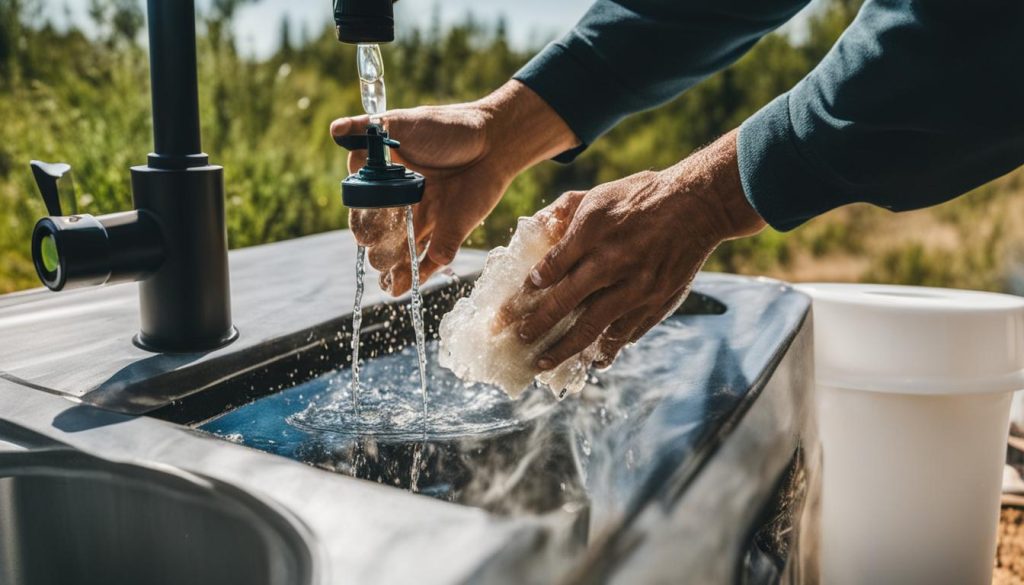
Tips for Maintaining Clean RV Water System
To ensure the cleanliness and safety of your RV water system, regular maintenance is crucial. Follow these tips to prevent water tank contamination, maintain fresh water tank cleanliness, and ensure the longevity of your RV’s water system:
- Regularly drain and flush your RV’s water tank: Sediment and debris can accumulate over time, leading to contamination. By draining and flushing your water tank periodically, you can remove these impurities and prevent bacterial growth.
- Use a water filter when filling your tank: Adding a water filter to your RV’s water system helps remove impurities and contaminants, ensuring cleaner water for drinking, cooking, and other uses. It’s an effective way to maintain the quality of the water in your tank.
- Avoid using non-potable water sources for filling your tank: Non-potable water sources, such as lakes or rivers, may contain harmful bacteria or contaminants that can compromise the cleanliness of your RV water system. Stick to using potable water sources to minimize the risk of contamination.
- Regularly check and clean your water pump and filters: The water pump and filters in your RV play a crucial role in maintaining the cleanliness of your water system. Regularly inspect and clean them to ensure proper functioning and remove any dirt or debris that may have accumulated.
Tip: It’s a good idea to keep a maintenance schedule and perform routine checks on your RV’s water system to catch any issues early on and prevent larger problems down the road.
By following these maintenance practices, you can keep your RV water system in optimal condition, preventing contamination and ensuring that you and your fellow travelers have access to clean and safe water throughout your journeys.
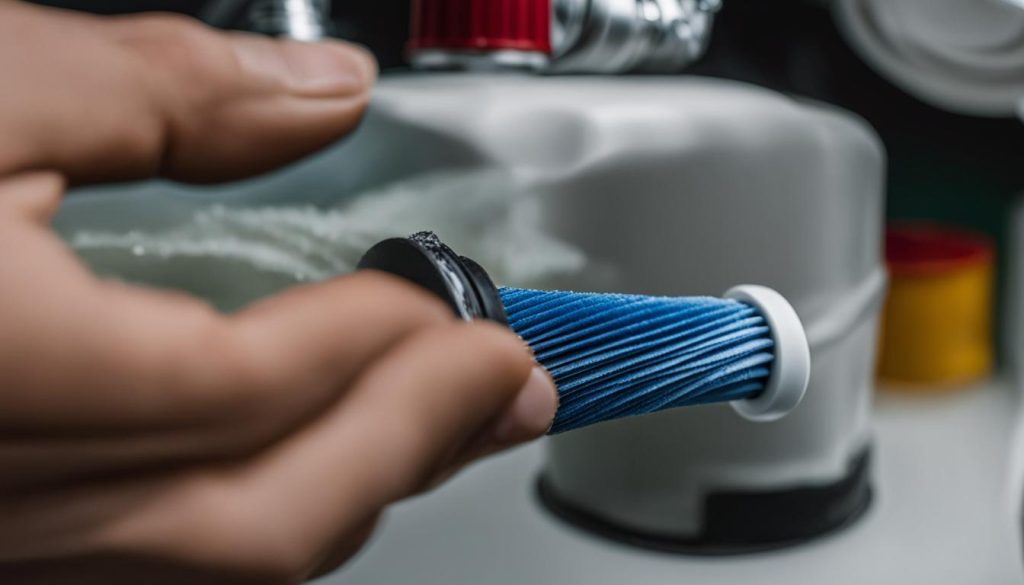
Recommended Products for RV Water Sanitization
While bleach is a commonly used sanitizer, there are also specialized products available specifically for sanitizing RV water systems. These products are designed to effectively kill bacteria and sanitize the water tank.
One top-rated option is Aqua Pure, which offers a bleach and water solution that is specifically formulated for RV water tanks. This product provides a convenient and effective way to sanitize your RV’s water system.
Another popular choice is Purogene, a water purifier that can be used to sanitize RV water tanks. Purogene is known for its ability to kill bacteria, viruses, and other contaminants, ensuring clean and safe water in your RV.
When choosing a product for RV water sanitization, it’s important to consider factors such as effectiveness, ease of use, and compatibility with your RV’s water system. Researching and reading customer reviews can help you find the best product for your needs.
FAQ
How often should you sanitize your RV fresh water tank?
It is generally recommended to sanitize your RV’s fresh water tank at least once a year. Some RVers choose to sanitize their water system every time their RV has been unused for 2-4 weeks.
What do you need to sanitize your RV fresh water tank?
You will need a measuring cup, funnel, 5-gallon bucket or water storage container, potable water hose, non-scented bleach or RV tank sanitizer, and optionally, a water tank filler.
How to sanitize RV fresh water tank with bleach?
The process involves turning off your water heater and water pump, draining the fresh water tank, calculating the amount of bleach needed, diluting it in water, and adding the mixture to your fresh water tank. Fill the tank with potable water and pump it through the system, allowing the bleach solution to circulate. Let the water sit for 12-24 hours before draining the tank.
What are the alternative methods for sanitizing RV fresh water tank?
Some RVers prefer using vinegar, which can be mixed with water and used in the same way as bleach. However, vinegar may not be as effective against certain types of bacteria and contaminants as bleach.
What are the tips for maintaining a clean RV water system?
Regularly drain and flush your RV’s water tank, use a water filter when filling the tank, avoid using non-potable water sources, and regularly check and clean your water pump and filters.
Are there recommended products for RV water sanitization?
Yes, there are specialized products available specifically for sanitizing RV water systems. Popular brands include Aqua Pure, which offers a bleach and water solution, and Purogene, which is a water purifier.

